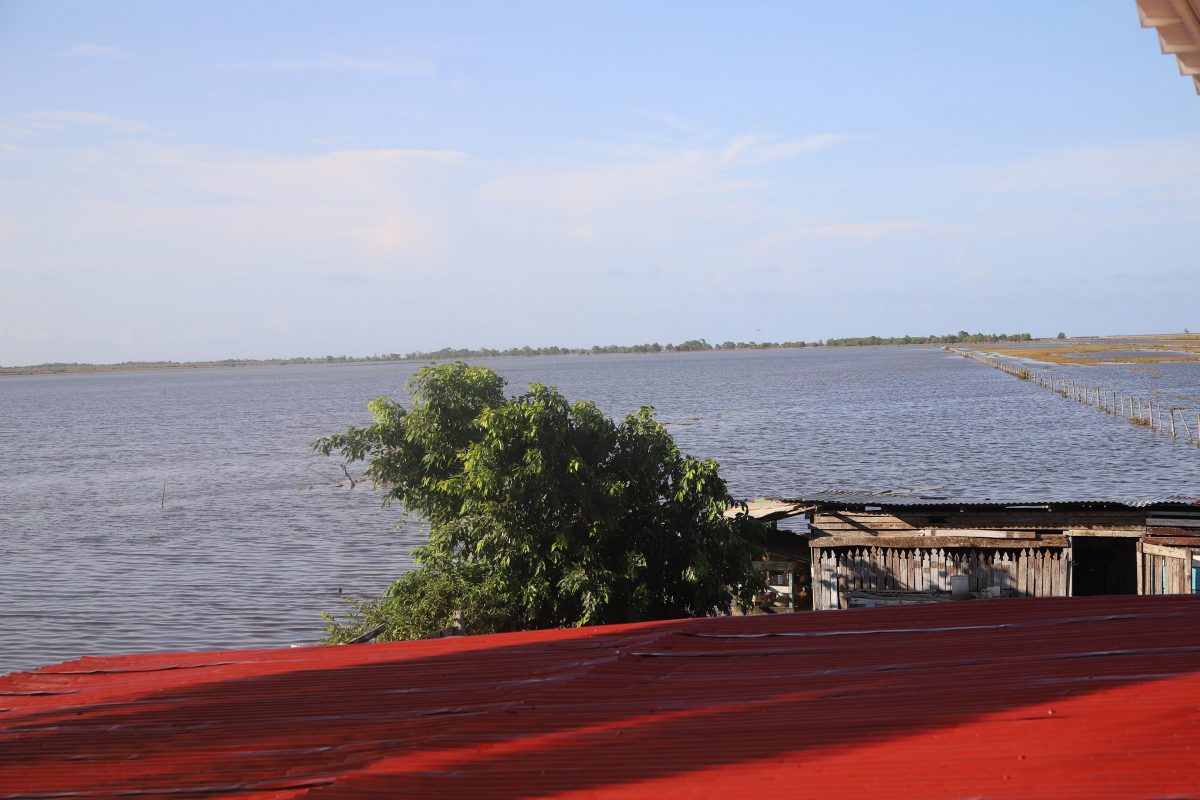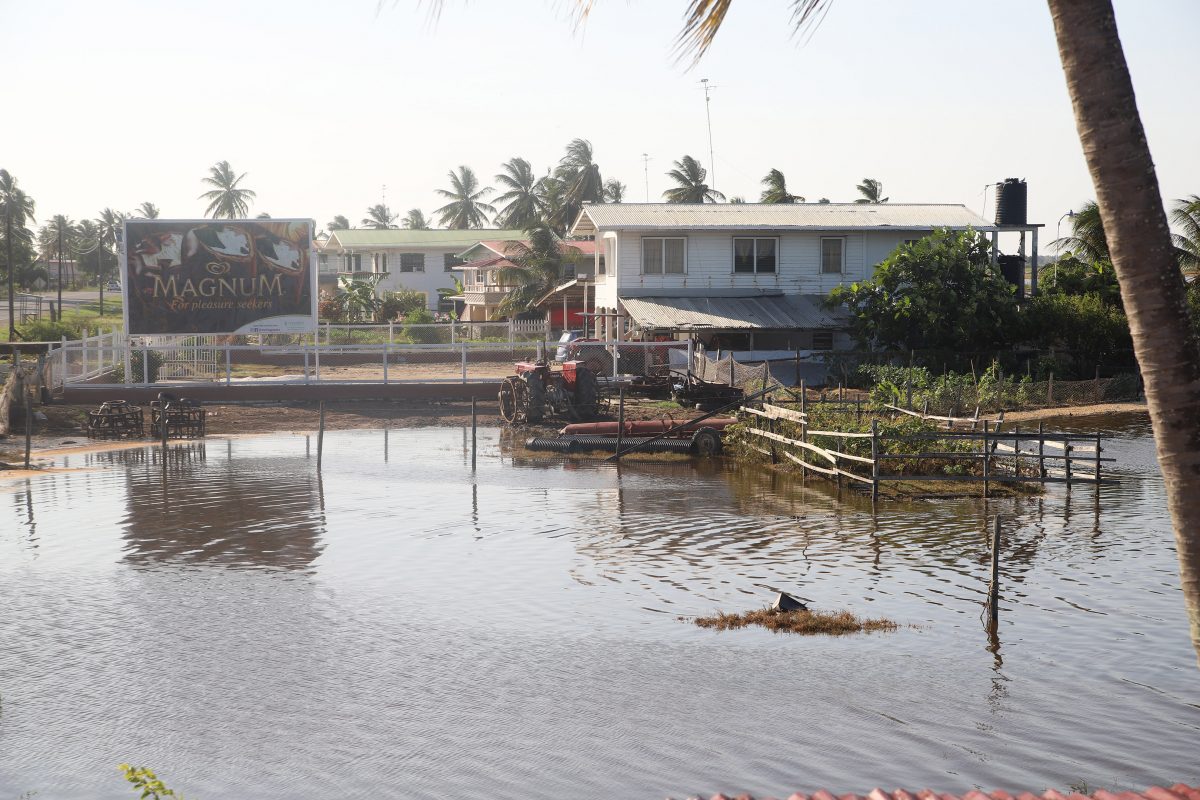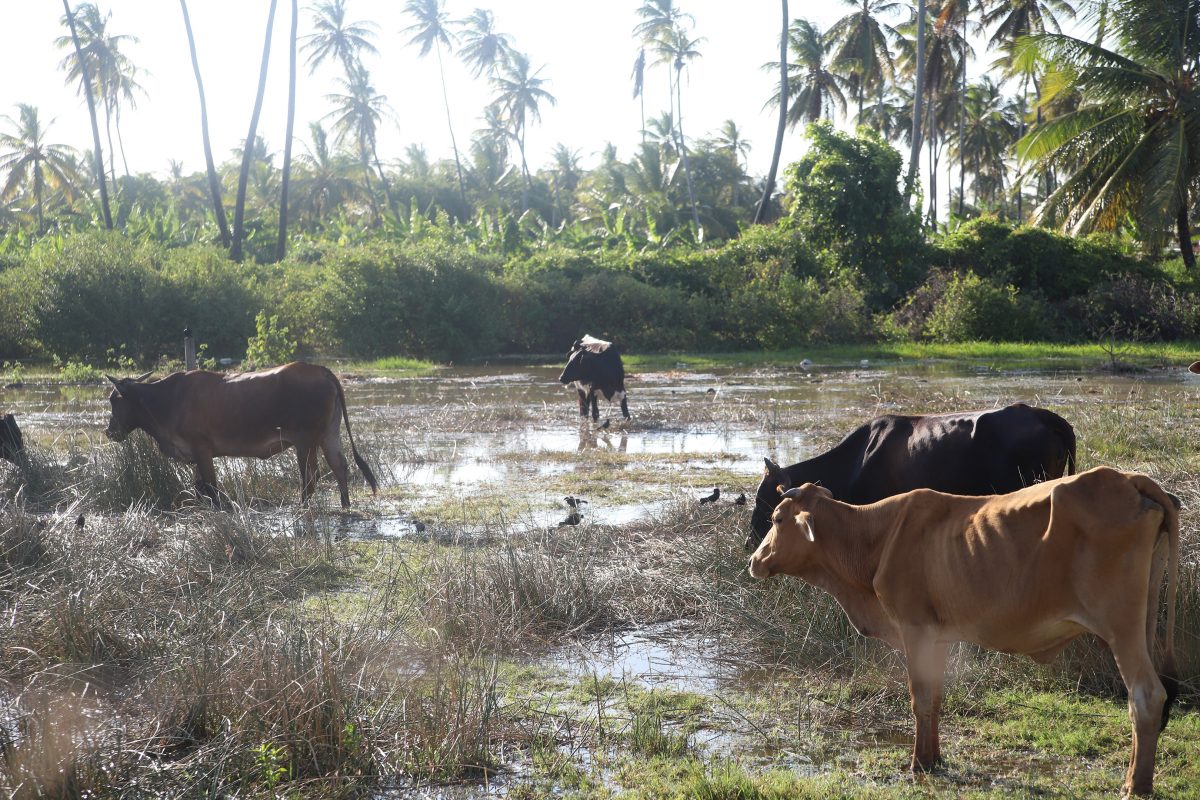Millions of dollars in crops and livestock were lost over the weekend along the Mahaicony coast following the extreme high tides.
Rice, cattle and poultry farmers were yesterday still counting their losses as an over 200-metre breach in the Danzigt sea defence dam exacerbated the effect of the tides in the Mahaica/Mahaicony areas.
According to a press release from the Ministry of Public Infrastructure’s Sea and River Defence Department, Chief Sea and River Defence Officer Kevin Samad reported to the Ministry on Sunday that the technical teams from the various Sea Defence District Offices have been monitoring vulnerable stretches of defence structures impacted by the spring tide and measures are being taken to minimise flood impacts where this is achievable in the immediate circumstances.
The spring tide, which commenced on September 26th, will be in effect until October 2nd. It is one of the highest tides recorded for this year. Based on the published tide tables, high tide levels in excess of 3.2m above Chart Datum were experienced, with a maximum high tide level of 3.36m above Chart Datum on September 29, 2019.
Based on a report from the Sea and River Defence Department, no major breaches of the sea and river defences have been reported, except for sections of the sea defence embankment along the Mahaicony shoreline, between Danzigt and Fairfield, which is currently being impacted by major erosion of the foreshore and depletion of the mangrove fringe.
“At Mahaicony, significant stretches of earthen embankment have been subjected to severe erosion and overtopping due to the exceptional natural erosion of the foreshore and the depletion of the system of mangrove. The critical condition of the shoreline has escalated due to the impacts of the current spring tide. Major breaches have occurred releasing salt water into the adjacent Bellamy Canal and agriculture lands. The Ministry has been executing emergency works at this location since March, 2019 to reinstate and protect compromised sections of embankments,” the release said.
When Stabroek News visited, acres of rice lands and small poultry and cattle farms along the Mahaicony coast remained inundated on Monday afternoon one day after the high tide.
A farmer from Prospect, Mahaicony, Khemwantia Jorree, told Stabroek News that following Sunday’s tides, the water level rose extremely high and even came into his home. He noted that a number of animals, including ducks and chickens, died and some wandered off in the water.
The man said that he would not be able to give an estimate of the amount of money lost due to the flooding of over 800 acres of rice lands that he cultivates. “It’s a lot of damage so far. The rice is way over in the millions. You talking about over 800 acres of rice. The poultry and thing had a lot of eggs and ducks and them things. You see it’s the salt water, nuff of them swim away,” Jorree said, while noting that this was the first occurrence of extreme flooding due to spring tides.
He went on to say that water also entered his home and the shop which he and his wife operate out of the home and they rushed to ensure that appliances and other valuables were placed out of the reach of the floodwater.
Jorree said the sea defence structure was not even visible as the tides came in and made the farmlands and ocean appear as one. He noted that just a few months ago officials were fixing a small breach in the sea defence.
Jorree told Stabroek News that the flooding would have a lasting impact on not just him. “The thing is that rice you can’t plant back here because the salt water damage the land now, so it’s the long term effect,” the man said as he added that even lands further inland south of the main road were inundated.
Another resident, whose home is located just south of the Prospect, Mahaicony main road, was also trying to come to grips with her losses. She has lands behind her home where she and her husband rear cattle, sheep and chicken. They were flooded.
The woman, who asked not to be named, pointed out that she also has a section of land just north of her home where the cattle graze and she had to rush to get them over to the land right next to her home. The water subsequently rose to such a height that those lands were covered as well. “The cows, there’s nothing we can do here, ’cause this side here is already under water too. It’s only the one one high spots here they gon be on,” the woman said.
“We got some (cows) over yesterday (Sunday) and some over this morning (Monday) thinking that they gonna be safe over this side but water start come up here too,” she added.
According to the woman, the southern half, where she resides, was not affected by Saturday’s tides but they were affected on Sunday.
She was not able to give an estimate of the losses and noted that they would have had over 40 cows and calves and they were not sure if any perished before they were able to get them over to the southern half of Prospect. She said that while there were not many precautionary measures that they could have taken to prevent the extreme damage and loss by the flood, they can only wait for the high tides to pass to subsequently assess and make plans for the best way forward.
She went on to say that it would appear as if they were hit with natural disasters back to back as previously some of their livestock and crops died due to a drought which had occurred a few months back. According to the woman, she thought of selling out the cattle that they had at the time. She added that they were also unable to plant rice as the drought occurred but were pleased to have rain so that they could have cultivated the crop again. “…We had all preparations to go back and plant rice and we had drought and we did not get to plant and then the rain come and we plant and now when the reaping time come something else come,” she lamented. At Rebecca’s Rust, along the Mahaicony coast, more houses and farmlands were seen inundated and one woman was seen attempting to save some items from her home as she prepared to leave and await the passing of the Monday afternoon tides. The woman, called Shana, told Stabroek News that she was barely able to save a few ducks from Sunday morning’s tides while the others would have wandered away or died. She noted that she only knew to look out for the flooding after being told by family members about the effects that the tides had on other coastal villages via the news and social media. “We had a breach out there look how long and it was never fixed,” Shana said.
Seeking to help
While Stabroek News was in Prospect, a team from the Civil Defence Commission (CDC) was there speaking with residents on proper health and safety and even distributing cleaning supplies to some of them. According to Captain S. October, a senior response officer, the CDC has been conducting assessments in the area and other affected communities along the Mahaicony coast. October told Stabroek News that while these communities are not disaccustomed to having some flooding during spring tides, there were other factors that contributed to the unprecedented flooding in the area.
“It is exacerbated because of one, the unusual high tides that are produced at this time but at the same time the defective work to the sea defence structures on the foreshore. And so, because those structures have failed, the water accumulation has been much more rapid and much more intensive,” October said.
The officer said the CDC was seeking to help residents to engage in proper sanitisation and disinfection of their homes so that they can return to normalcy. He stressed that disease transmission can be heightened at these times if adequate precautions are not taken.
According to October, the CDC has been working in collaboration with the Regional Democratic Council (RDC), the Neighbourhood Democratic Councils (NDC) and other entities like the Ministry of Public Infrastructure, Guyana Livestock Development Agency (GLDA). “What we observed as well through this process of evaluation and assessment is that a lot of persons also and equally did not take the time to fully appreciate some of those warnings that we ourselves would have provided to them,” he added, while noting that they would have been in the area early Sunday morning providing warnings to residents.
“I think what is most troubling is the number of losses some farmers would have faced and suffered including loss to small agricultural plots, livestock… and those are some key issues we want to prevent in the future,” October said, while noting that through their collaborative efforts they would have the GLDA and NAREI provide a response to the challenges that the farmers faced so that they can recover as quickly as possible.
October noted that at that time they would have identified about 16 farmers and households that would have been directly impacted.
Meanwhile, the Ministry of Public Infrastructure release said numerous areas along the coast experienced mild to severe flooding due to overtopping of revetments, seawalls and earthen embankments in locations in regions 2, 3, 4 and 6.
It noted that areas impacted by overtopping include: Cullen and Onderneeming on the Essequibo Coast; Cane Garden, Cane Field, Elizabeth Ann, Waterloo, Maryville, Retrieve and Blenheim on the island of Leguan; Zeelandia, Maria’s Pleasure, Belle Plaine, Sans Souci, and Moorfarm on the island of Wakenaam; Parika, Den Amstel, Anna Catherina, Hague, and Uitvlugt on the West Coast of Demerara; New Hope, Good Success, Friendship and Garden of Eden on the East Bank of Demerara; Helena along the Mahaica River; and New Amsterdam, Sheet Anchor and Wellington Park in Region 6.
With regard to the measures being taken to minimise the impacts of the current spring tide, Samad indicated the Sea and River Defence Force Account Units have been working to heighten vulnerable sections of earthen embankment and reinforce stretches of revetment and sea walls to minimise the extent of overtopping.
Additionally, the release said contractors have been engaged to reinforce and heighten revetments and desilt drainage canals that function to contain overtopping discharge, as well as community drains. The Sea and River Defence Department will be programming major rehabilitation and reconstruction interventions to strengthen the flood protection infrastructure in all impacted areas.
The release also said that in keeping with the Ministry’s Sea and River Defence Sector Policy, a holistic upgrading of the Coastal Flood Protection System is progressively being undertaken to achieve an acceptable level of flood resilience against the rise in sea level and the effects of climate change.
Strategic measures will be required at a national level to reduce flood vulnerability through engineered interventions, strategic land use planning and a risk-based approach to shore zone management.
Samad noted that a formidable constraint has been limited funding to implement the projects envisaged.
Residents of low-lying coastal communities were advised to take the needed precautions during the remainder of the spring tide period.













